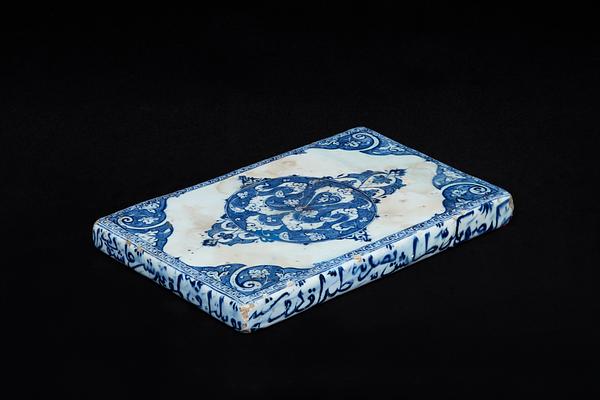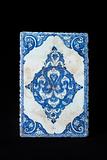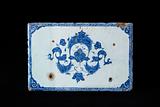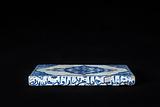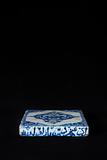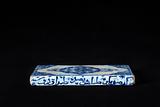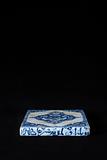The front and back of the plaque are adorned with undulating cloud ornaments and flowers on thin, interlacing vines. The decorations are done in the so-called
Baba Nakkas style seen in much Ottoman courtly art from the period c. 1470 to 1530.
[1] Named after a designer in the Ottoman court studio (
Nakkashane), the style combines East Asian cloud and floral motifs with the older, Middle Eastern arabesque tradition and its characteristic elongated leaves. The style is also seen on a wall tile from around 1505 (
93a/2003).
Baba Nakkas designs are known from other art forms than ceramics, including bookbinding, and with its shape and decoration this plaque is reminiscent of several bindings designed by Sultan Bayazid II’s court calligrapher Shaykh Hamdullah (d. 1520).
[2]An inscription running along the edges of the plaque further increases its similarity to a book. The inscription contains verses expressing a lover’s willingness to go to his death or isolate himself in the wilderness for the sake of love. The verses are by the poet Necati Bey (d. 1509), who was a central figure in early Ottoman poetry, and who had close ties to the son of Bayazid II, Prince Mahmud (d. 1507).
[3]The intended purpose of the plaque is unclear, and there are no other known pieces of this kind to shed light on its possible function. The thickness of the plaque and the fact that it is painted on all sides make it unlikely that it was used as a wall tile. It has been suggested that it might be a paperweight. While this would explain the object’s resemblance to a bound book, the idea must be regarded as one among several theories.
It is also possible that the plaque is the result of an experiment, which was never repeated on a wider scale. One certainly sees that the artisan struggled to control the blue colour and keep it from running in some areas.
On the back of the plaque are four marks left by the stand on which it rested during firing. Two of these marks have subsequently been drilled and filled with lead to assist mounting.
